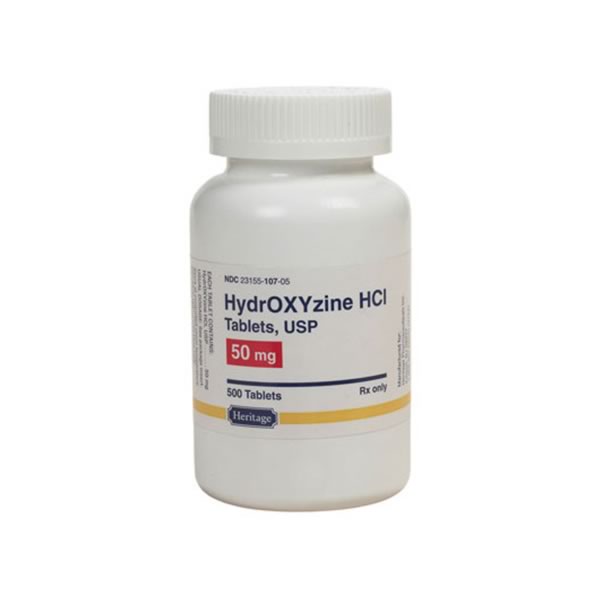Hydroxyzine, commonly known by its brand name Vistaril, is an antihistamine medication that is used for various purposes, including the treatment of anxiety, itching due to allergies, and as a pre-operative sedative. The 50 mg dosage is a common strength prescribed by healthcare professionals for its effectiveness in managing these conditions. In this comprehensive overview, we explore the uses, mechanism of action, dosage, potential side effects, and considerations associated with Hydroxyzine (Vistaril) 50 mg.
Uses and Indications:
Hydroxyzine has a diverse range of uses, and its indications can vary depending on the symptoms being addressed. One of the primary uses is in the treatment of anxiety and tension. Hydroxyzine is often prescribed for individuals experiencing mild to moderate anxiety, providing relief without the potential for dependence associated with some other anxiolytic medications.
Additionally, Hydroxyzine is utilized to manage itching caused by various allergic conditions, such as chronic hives or contact dermatitis. The antihistamine properties of Hydroxyzine help to alleviate itching by blocking the effects of histamine, a substance released during allergic reactions.
As a pre-operative medication, Hydroxyzine may be administered to induce sedation and reduce anxiety before medical procedures. This can contribute to a smoother and more comfortable experience for individuals undergoing surgery or certain medical interventions.
Mechanism of Action:
Hydroxyzine works as an antihistamine by blocking the effects of histamine, a chemical released by the body during allergic reactions. Histamine is responsible for various symptoms associated with allergies, including itching, swelling, and rashes. By inhibiting the action of histamine, Hydroxyzine helps to alleviate these symptoms, providing relief to individuals with allergic conditions.
In the context of anxiety, Hydroxyzine’s mechanism of action is not fully understood. It is believed to exert its anxiolytic effects by affecting certain neurotransmitters in the brain, such as serotonin. The sedative properties of Hydroxyzine contribute to its use as a pre-operative medication, helping individuals relax before medical procedures.
Dosage and Administration:
Hydroxyzine is available in different strengths, with the 50 mg dosage being a common prescription. The dosage prescribed can vary based on the specific condition being treated, the individual’s age, weight, and overall health. It is crucial for individuals to take Hydroxyzine exactly as prescribed by their healthcare provider, and any adjustments to the dosage should be made under the guidance of a medical professional.
When used for anxiety or tension, Hydroxyzine is typically taken orally, with or without food, as directed by the healthcare provider. The medication may be taken on an as-needed basis or according to a regular schedule, depending on the nature and severity of the anxiety symptoms.
For individuals experiencing itching due to allergies, the dosage and frequency may also vary based on the specific condition. It is important to follow the prescribed regimen to achieve optimal relief from itching.
Side Effects and Considerations:
Hydroxyzine is generally well-tolerated, but like any medication, it can be associated with certain side effects. Common side effects may include drowsiness, dizziness, dry mouth, and blurred vision. These side effects are often mild and temporary, but individuals should exercise caution, especially when engaging in activities that require alertness, such as driving or operating machinery.
In some cases, Hydroxyzine may cause paradoxical reactions, leading to increased agitation, restlessness, or excitability. If these reactions occur, individuals should seek medical attention promptly.
Serious side effects are rare but can include allergic reactions such as rash, itching, swelling, severe dizziness, or difficulty breathing. Any severe or persistent side effects should be reported to a healthcare provider immediately.
It is important for individuals to inform their healthcare provider about their complete medical history, including any pre-existing conditions, allergies, or medications they are currently taking. This information helps the healthcare provider make informed decisions about the appropriateness of Hydroxyzine for the individual.
Special Populations:
Certain populations may require special considerations when using Hydroxyzine. Pregnant individuals and those breastfeeding should discuss the potential risks and benefits of using Hydroxyzine with their healthcare provider. While the medication is generally considered safe, individual circumstances may vary.
Elderly individuals may be more susceptible to the sedative effects of Hydroxyzine, and the dosage may need to be adjusted accordingly. Individuals with a history of certain medical conditions, such as glaucoma, urinary retention, or cardiovascular issues, should use Hydroxyzine with caution, and the decision to prescribe the medication should be made in consultation with a healthcare provider.
Conclusion:
Hydroxyzine (Vistaril) 50 mg is a versatile medication used for the treatment of anxiety, allergic itching, and pre-operative sedation. Its antihistamine properties make it effective in alleviating symptoms associated with allergies, while its anxiolytic and sedative effects contribute to its use in managing anxiety and tension.
The medication is generally well-tolerated, and the 50 mg dosage is commonly prescribed to achieve the desired therapeutic effects. Individuals using Hydroxyzine should do so under the guidance of a healthcare professional, strictly adhering to prescribed dosages and reporting any side effects promptly.
Open communication between patients and healthcare providers ensures an individualized approach to treatment, taking into consideration factors such as medical history, age, and concurrent medications. Hydroxyzine remains a valuable tool in the management of various conditions, providing relief and improving the overall well-being of individuals dealing with anxiety, allergic reactions, or pre-operative anxiety.





Reviews
There are no reviews yet.